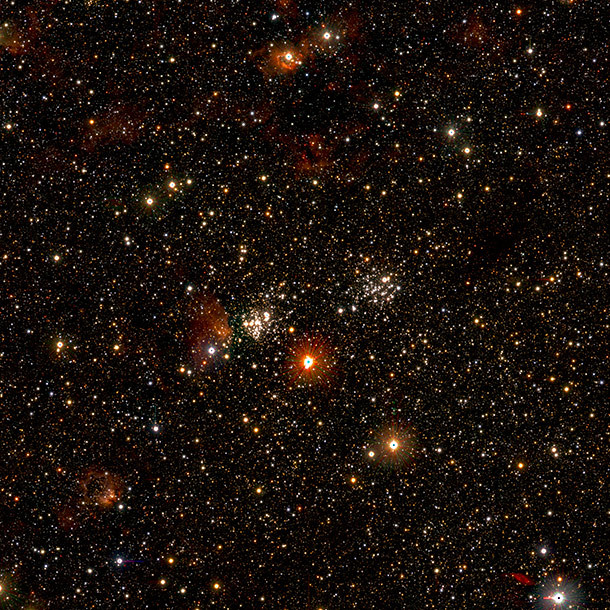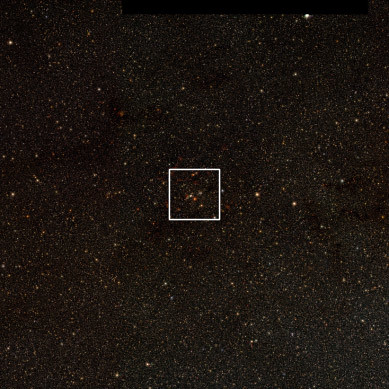Create a free profile to get unlimited access to exclusive videos, sweepstakes, and more!
To grasp a billion stars

There are times -- rare, but they happen -- when I have a difficult time describing the enormity of something. Something so big, so overwhelming, that words simply cannot suffice.
The basic story is: Using the VISTA telescope in Chile and the UKIRT telescope in Hawaii, astronomers have made an incredibly detailed map of the sky in infrared. This map will help understand our own galaxy, more distant galaxies, quasars, nebulae, and much more.
But what do I mean by "incredibly detailed"?
This is where words get hard. So hang on tight; let me show you instead.
Here's a section of the survey they made, showing the star-forming region G305, an enormous cloud of gas about 12,000 light years away which is busily birthing tens of thousands of stars:
[Click to enstellarnate.]
Pretty, isn't it? There are about 10,000 stars in this image, and you can see the gas and dust that's forming new stars even as you look.
But it's the scale of this image that's so amazing. It's only a tiny, tiny part of this new survey. How tiny? Well, it came from this image (the area of the first image is outlined in the white square):
Again, click to embiggen -- it'll blow your socks off. But we're not done! That image is a subsection of this one:
... which itself is a subsection of this image:
Sure, I'll admit that last one doesn't look like much, squished down into a width of a few hundred pixels here for the blog. So go ahead, click on it. I dare you. If you do, you'll get a roughly 20,000 x 2000 pixel picture of the sky, a mosaic made from thousands of individual images... and even that is grossly reduced from the original survey.
How big is the raw data from the survey? Why, it only has 150 billion pixels aiieeee aiieeeeee AIIEEEEE!!!
And this would be where I find myself lacking in adjectives. Titanic? Massive? Ginormous? These all fail utterly when trying to describe a one hundred fifty thousand megapixel picture of the sky.
Yegads.
And again, why worry over words when I can show you? The astronomers involved helpfully made the original data -- all 150 billion pixels of it -- into a pan-and-zoomable image where you can zoom in, and in, and in. It's hypnotizing, like watching "Inception", but made of stars.
And made of stars it is: there are over a billion stars in the original image! A billion. With a B. It's one of the most comprehensive surveys of the sky ever made, and yet it still only scratches the surface. This survey only covers the part of the sky where the Milky Way galaxy itself is thickest -- in the bottom image above you can see the edge-on disk of our galaxy plainly stretching across the entire shot -- and that's only a fraction of the entire sky.
Think on this: there are a billion stars in that image alone, but that's less than 1% of the total number of stars in our galaxy! As deep and broad as this amazing picture is, it's a tiny slice of our local Universe.
And once again, we've reached the point where I'm out of words. Our puny brains, evolved to count the number of our fingers and toes, to grasp only what's within reach, to picture only what we can immediately see -- balk at these images.
But... we took them. Human beings looked up and wondered, looked around and observed, looked out and discovered. In our quest to seek ever more knowledge, we built the tools needed to make these pictures: the telescopes, the detectors, the computers. And all along, the power behind that magnificent work was our squishy pink brains.
A billion stars in one shot, thanks to a fleshy mass of collected neurons weighing a kilogram or so. The Universe is amazing, but so are we.
Images credit: Mike Read (WFAU), UKIDSS/GPS and VVV
Related Posts:
- Tour the galaxy with this pan-and-scan all-sky picture!
- What does a half million galaxies look like?
- An ultradeep image thatâs *full* of galaxies!
- Adler planetarium unleashes 2.5 gigapixel image of the galaxy
- The new VLT Survey Telescope delivers spectacular images






























